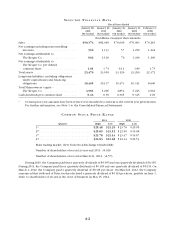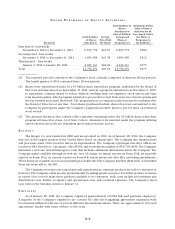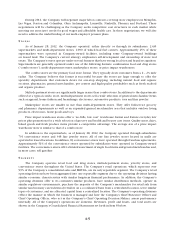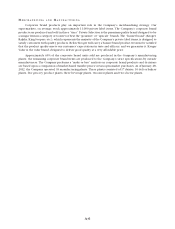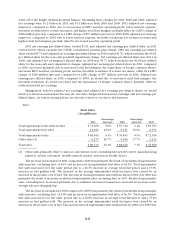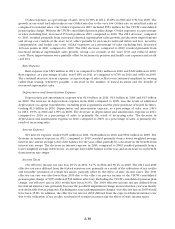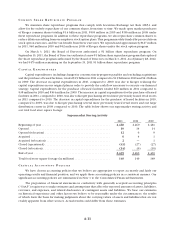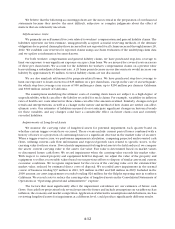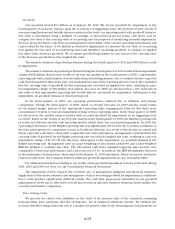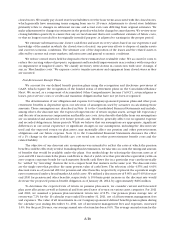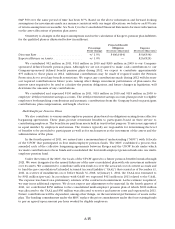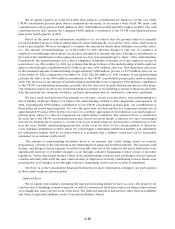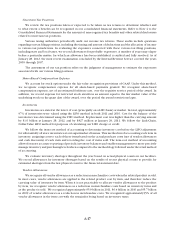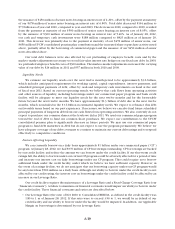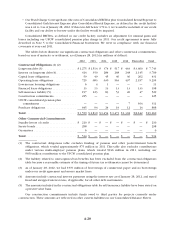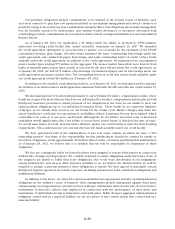Kroger 2011 Annual Report Download - page 67
Download and view the complete annual report
Please find page 67 of the 2011 Kroger annual report below. You can navigate through the pages in the report by either clicking on the pages listed below, or by using the keyword search tool below to find specific information within the annual report.A-12
We believe that the following accounting policies are the most critical in the preparation of our financial
statements because they involve the most difficult, subjective or complex judgments about the effect of
matters that are inherently uncertain.
Self-Insurance Costs
We primarily are self-insured for costs related to workers’ compensation and general liability claims. The
liabilities represent our best estimate, using generally accepted actuarial reserving methods, of the ultimate
obligations for reported claims plus those incurred but not reported for all claims incurred through January 28,
2012. We establish case reserves for reported claims using case-basis evaluation of the underlying claim data
and we update as information becomes known.
For both workers’ compensation and general liability claims, we have purchased stop-loss coverage to
limit our exposure to any significant exposure on a per claim basis. We are insured for covered costs in excess
of these per claim limits. We account for the liabilities for workers’ compensation claims on a present value
basis utilizing a risk-adjusted discount rate. A 25 basis point decrease in our discount rate would increase our
liability by approximately $5 million. General liability claims are not discounted.
We are also similarly self-insured for property-related losses. We have purchased stop-loss coverage to
limit our exposure to losses in excess of $25 million on a per claim basis, except in the case of an earthquake,
for which stop-loss coverage is in excess of $50 million per claim, up to $200 million per claim in California
and $300 million outside of California.
The assumptions underlying the ultimate costs of existing claim losses are subject to a high degree of
unpredictability, which can affect the liability recorded for such claims. For example, variability in inflation
rates of health care costs inherent in these claims can affect the amounts realized. Similarly, changes in legal
trends and interpretations, as well as a change in the nature and method of how claims are settled can affect
ultimate costs. Our estimates of liabilities incurred do not anticipate significant changes in historical trends
for these variables, and any changes could have a considerable effect on future claim costs and currently
recorded liabilities.
Impairments of Long-Lived Assets
We monitor the carrying value of long-lived assets for potential impairment each quarter based on
whether certain trigger events have occurred. These events include current period losses combined with a
history of losses or a projection of continuing losses or a significant decrease in the market value of an asset.
When a trigger event occurs, we perform an impairment calculation, comparing projected undiscounted cash
flows, utilizing current cash flow information and expected growth rates related to specific stores, to the
carrying value for those stores. If we identify impairment for long-lived assets to be held and used, we compare
the assets’ current carrying value to the assets’ fair value. Fair value is determined based on market values
or discounted future cash flows. We record impairment when the carrying value exceeds fair market value.
With respect to owned property and equipment held for disposal, we adjust the value of the property and
equipment to reflect recoverable values based on our previous efforts to dispose of similar assets and current
economic conditions. We recognize impairment for the excess of the carrying value over the estimated fair
market value, reduced by estimated direct costs of disposal. We recorded asset impairments in the normal
course of business totaling $37 million in 2011, $25 million in 2010 and $48 million in 2009. Included in the
2009 amount are asset impairments recorded totaling $24 million for the Ralphs reporting unit in southern
California. We record costs to reduce the carrying value of long-lived assets in the Consolidated Statements of
Operations as “Operating, general and administrative” expense.
The factors that most significantly affect the impairment calculation are our estimates of future cash
flows. Our cash flow projections look several years into the future and include assumptions on variables such as
inflation, the economy and market competition. Application of alternative assumptions and definitions, such as
reviewing long-lived assets for impairment at a different level, could produce significantly different results.


